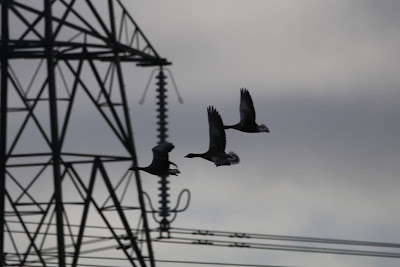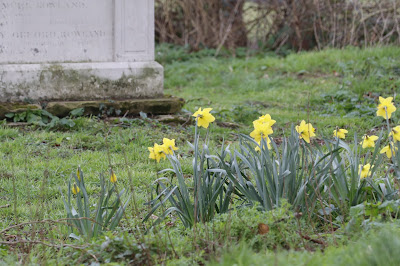There is a little church with a cemetery, which this GOLDFINCH appreciated as somewhere to perch.
Nature isn't doing too well in the general countryside, in fact its barely surviving as it holds on whilst modern agriculture destroys everything in its way. The countryside is an industrial waste land devoid of anything resembling nature. Yes there are still great areas for wildlife, the Minsmeres of the worlds, but they are the exception, that have somehow survived despite our best efforts. My Local Patch is no exception, formed of large prairie fields, featureless expanse of crops dedicated to growing food at the sake of everything else. There are token areas for wildlife, little hedgerows that are allowed to grow but are brutally cut back, often for no reason. LITTLE OWLS once nested in the area before the farmer cut down the tree they nested in, again for no reason as it didn't improve access or anything, it was cut down for the sake of destroying somthing natural.
RED DEAD NETTLES. They are "dead" because they don't sting, have red flowers and look like nettles.
Any areas of tall trees left exist around the inhabited areas, the buildings. There is a small pond in the area and an irrigation reservoir, but they offer little beyond a token area of habitat.There is a church with attendant cemetery which provides a bit of an oasis of trees and grassland. The church seems to serve only one hall as there are no other houses in the area.
I while away the hours here rambling the many footpaths that criss cross the area, just myself and the birds. I take the camera with me as you can see from all the photos, but I seldom get any good shots. Sometimes it doesn't matter if I don't see anything, and I seldom do here, its just that I need that connection with nature.
SNOWDROPS growing in the church cemetery
Signs of spring began after a brief snow flurry in late January, when the first SNOWDROPS appeared in various places. They were soon joined by DAFFODILS and CELENDINE, all common harbingers of spring.On 22 Jan I saw my first BUTTERFLY of the year, an absurdly early RED ADMIRAL, which may even have been wintering. The next BUTTERFLY was a yellow BRIMSTONE on the 22 February which is still pretty early.
The female of the resident KESTRELS - Suffolk Punch Field
The winter was the warmest on record and as a result a lot of birds were fooled into singing earlier than usual. February was as warm, if not warmer than April.
The first SKYLARK of the year was on the 22 January, a declining resident bird that still manages to cling on in the area.
By the end of January GREAT SPOTTED WOODPECKERS had started drumming on the tall trees that surround the pond, and there were two pairs of GREEN WOODPECKER in the area. In February more birds had started singing, with two SONG THRUSHES, and three YELLOWHAMMERS, slightly lower numbers than last year.
On 11 March I heard the first CHIFFCHAFF of the year, singing its two note tune, which gives it its name. Soon they were found everywhere there were any tree growth.
DAFFODILS in the church cemetery
March was a bit more like March should be, less predictable, not so sunny, but there was no rain, drought conditions still prevail. Various THRUSHES moved through in that month, however they have mainly been in small numbers, its been several years since we've had any large influxes. The largest flock this Spring was of forty FIELDFARE in mid March.
Male CHAFFINCH
The first BLACKTHORN appeared on the 4 March about two weeks earlier than last year, but was soon over. They were soon replaced by HAWTHORN, again very early.
During March some of the fields had been ploughed and sown with crops, whilst fields planted in Autumn became too tall for any nesting birds.
One of the strangest things to be dumped on the local path - an old rusted exercise bike
April was again unpredictable. Mid-month held hail and snow storms, and there was a light frost. But still no rain.
By the end of the month WHITETHROATS had returned, their buzzy call emanating from the hedgerows, the occasional song flight, a reall feature of late spring and indicates they have wintered well in Africa.
By the end of the month WHITETHROATS had returned, their buzzy call emanating from the hedgerows, the occasional song flight, a reall feature of late spring and indicates they have wintered well in Africa.
SWALLOWS have also been seen catching insects over the grassy fields. A few still nest in the farm buildings on the patch.
Nice view of the Local Patch.
In the first week of May the first SWIFTS returned to the skies above Ipswich, the same time as most years. They are one of the latest returning birds, and are usually the first to leave as well. Their wheeling through the sky is greatly entertaining.
May brought monsoon weather, as if all the weather had been built up and was forced out in the space of a week.
There is a resident flock of GREYLAG GEESE in the area around the pond.
There has been a BLACKBIRD with white splodges on its body that has been living on the patch for at least four years, it doesn't migrate or anything, choosing to spend its time in the patch throughout the year. It must be really old now for a BLACKBIRD.
Farmer ploughing a field near Shrublands.
On 20 May a ROE DEER was in the Suffolk Punch Field, a rare visitor to these parts, and a female COMMON BLUE was in the meadow by the Reservoir.
Settled in the local countryside is a tiny area of ancient woodland called Rede Wood. This used to be a county wildlife site, but the local council flogged it off to someone, to save what little money an ancient woodland costs. This is just the typical under appreciation of our native wildlife by the powers that be, I mean would they sell off some work of art so easily?
Male BLACKCAP
The canopy is very open, a lot of trees have been felled, but replanted, but it means the understorey is very scrubby, which in turns attracts lots of BLCAKCAPS. A GREAT SPOTTED WOODPECKER was heard drumming, and there were lots of commoner birds all twinkling away.There is a small display of BLUEBELLS under an area of hazel coppice, but not the large drifts you would associate with ancient woodland, because it was so overgrown.
Hopefully this sums up spring on the Local Patch well enough. This is an area I know so well, I have been coming here pretty much straight after first moving into the area over six years ago. I know the area blind folded, know all the passing of the seasons, yet I'm not really rewarded, I seldom see anything unusual to pay for the the coverage I have given it. Such is life


















No comments:
Post a Comment